I made quite a few dives beneath the sea ice in Antarctica, but this one stands out as one of the most memorable.
BENEATH THE ICE
by
Jim Mastro
It was a good day for a dive. The sky was clear and the air calm. That was unusual enough for early November, but we were also experiencing a heat wave. The temperature hovered only a few degrees below freezing, and reflected sunlight from the surrounding ice and snow made it seem even warmer. Inside our Spryte, a slow and uncomfortable tracked vehicle, we were sweating.
Our journey across the frozen sea had become progressively bumpier as we crossed from new ice to old. Mounds of wind-sculpted snow caused the nose of the Spryte to pitch up sharply, then come down with a jarring crash.
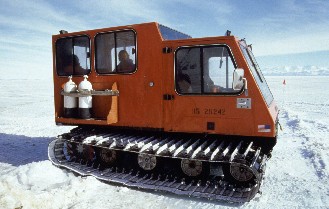
Spryte with scuba cylinders
Sea ice travel is hazardous even in the best of conditions (and these were the best of conditions). Hidden cracks and unexpectedly thin ice have swallowed several vehicles–and people–in the short history of Antarctic research. All eyes were on the untested ice in front of us as we inched forward.
Our goal, the Weddell seal breeding colony at Hutton Cliffs, still seemed very far away. The white cone of Mount Erebus loomed directly in front of us, a long plume of volcanic smoke streaking from its summit. On our left I could see the dark line of the Erebus Ice Tongue, a glacier that rolls off the slopes of Erebus and stretches improbably into the ice-locked waters of the Sound. To our right, the slopes of Hut Point Peninsula stretched back to our point of origin, McMurdo Station, Ross Island, Antarctica.
In the back of the van-like Spryte, Malcolm Ludgate, an Australian cinematographer on assignment, tried to protect his expensive gear from the bumpy ride. His intention, and the purpose of our journey, was to film Weddell seals in their icy underwater home.
Both scuba diving and filming underwater in Antarctica pose their own special challenges. The year-round temperature of the sea water in McMurdo Sound is -1.8̊ Celsius (28̊F). It’s the coldest water on Earth, and it tests both divers and their equipment to the extreme. Regulators can freeze up and free flow, a tendency that is both annoying and dangerous. Hands can become so numb that operating equipment becomes difficult or impossible.
Of course, Antarctic diving also has its positive points. Foremost among these is the unparalleled visibility. From July through October (late winter to early spring) the underwater visibility in McMurdo Sound can be as much as 900 feet. I expected today’s visibility to be at least half that.
The roar of the Spryte’s engine was beginning to grate on me, but the end was in sight. After swinging wide around an ice-locked island called Turtle Rock to avoid large cracks, we zeroed in on our goal. Hutton Cliffs stood just a few hundred yards away, a sheer wall about 100 feet high and caked in ice. We aimed the Spryte toward the east end, where snow had accumulated to form a precariously overhanging lip.
The sea ice in this area showed its age. The surface was pitted and cracked, and polished to a slick, blue finish by years of windblown snow and dust. The steel bars of the Spryte’s tracks rattled and squeaked as we lumbered across it. Immediately next to the cliff was a pressure ridge, a wall of broken ice chunks thrust skyward by repeated tidal and ice sheet action. We pulled the Spryte as close as possible to this wall and clambered out, happy to be free of the cramped vehicle.
There were seals everywhere. Many were mothers nursing their newborn pups. A few raised their heads to look us over, then went back to sleep. We did our best not to disturb them as we searched the pressure ridge for a place to enter the water.
We were in luck. Behind the pressure ridge the ice sheet had pulled away from the wall of the cliff to form an open, three-foot-wide crack. It was perfect. We began pulling our gear out of the Spryte and preparing for the dive.
My first task was to deploy the “down line.” This is a thick, weighted line with brightly colored flags and underwater strobe lights attached along its length. The down line is lowered into the water from every dive site to clearly mark the entry point from below.
Divers who have ignored the “down line” rule have courted disaster. A few years ago, two scientists lost their ice hole during a deep dive. One of them conveyed to me the gut-wrenching feeling of suddenly knowing his life was measured by the dwindling volume of air in his tank. After a frantic, desperate search, they found the hole–with only a few breaths remaining in their tanks. Another minute would have been fatal.
I attached a spare tank and regulator to one end of the line (another safety precaution), secured the other end to a post drilled into the ice, and lowered the line into the clear water. It fell straight, like a carpenter’s plumb–a good sign. There would be no current to worry about.
Malcolm and his assistants had brought his 300 pound camera and underwater housing to the edge of the crack and were busily preparing it for the dive. I decided to wait as long as possible before suiting up. On a warm day like today, I knew I’d overheat rapidly in my dry suit.
I studied the seals lying calmly all around me. Their musty, musky smell was pervasive, though the low temperature kept the odor from becoming overwhelming. In the distance I could hear pups mewling hungrily for their mothers. One young fellow nearby lifted his head away from a nipple to stare at me with large eyes. What sense would a Weddell seal pup make of humans? I wondered. Though his mother might consider us overly tall and ugly penguins, he was too new to have seen any of his fellow Antarctic inhabitants.
And what would he think of the world he had been born into, with its car-sized, jagged chunks of ice jutting skyward? Looking around, I felt as though I were standing in some mythical frozen forest. Clearly, the impending dive would be vastly different from the others I had made around McMurdo. On those dives the ice cover had generally been a uniform, flat sheet, a lid on the sea that looked almost the same from below as from above. Here at Hutton Cliffs, I didn’t know what to expect.
“Camera’s ready,” Malcolm said with a glance in my direction.
With the help of Alison, my dive tender, I began to suit up. By the time my dry suit had been zipped shut, I was already too hot. Then came the tanks, a heavy set of twin 71.2’s outfitted with two independent regulators. I slipped the spare regulator mouthpiece into its holder, a place where I could find it easily and quickly. Then, with gauges and computer firmly attached to my arms, I rinsed out my mask. Finally, Alison helped me put on and fasten my bulky gloves.
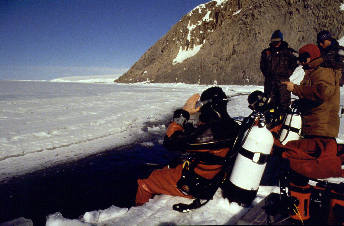
Suiting up to make a dive
By now Malcolm had finished suiting up and had entered the water. His assistants carefully lowered the massive camera down to him. After carefully checking the electronic leak indicator, he signaled his readiness. I slipped on my mask, triple checked my gear, and plunged in after him.
The icy water struck the only exposed part of my flesh–the area around my mouth–and numbed it almost immediately. I hardly noticed. The water was completely transparent. I felt as though I had suddenly become suspended in air. Fifty feet below, the substrate of black, volcanic rock was incongruously sprinkled with various light-colored invertebrates–sponges, starfish, anemones, and sea spiders. The effect made it seem as though they had been tossed out of the back of a truck.
The same bottom sloped steeply upward toward the cliff to my right, where it met a solid wall of ice. To my left, the underside of the ice sheet was a maelstrom of different shades of blue and purple. Malcolm was about thirty yards ahead, pushing his ungainly camera toward an underwater bridge of splintered ice. I followed.
We passed through a narrow tunnel formed by crushed and deformed ice blocks. When we emerged on the other side, the bottom had disappeared. We were suddenly suspended in an endless, blue universe, as though we had been abruptly cast into space.
The topography around us was stunning. Above, the bright, ragged line of the crack stretched ahead as far as I could see. On either side of us the tortured ice showed the results of years of relentless pressure and pounding. Enormous blocks, some the size of small buildings, jutted everywhere in splendid profusion. It was as though a great being had emptied his cosmic ice cube tray into the water along Hutton Cliffs. The jumble of ice had created gargantuan caverns, dark tunnels, and sheer walls of hard blue that literally disappeared into the depths.
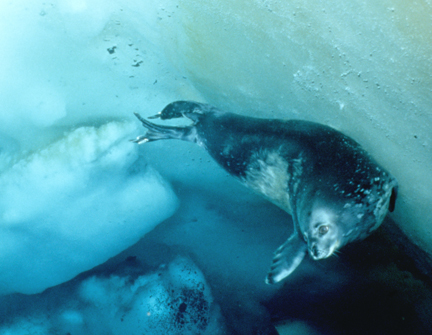
Young Weddell seal
This was assuredly a world unlike any other on Earth. Everywhere there were seals. Some slept soundly on narrow shelves of ice, surfacing only when the need to breathe forced them up. Others, breeding males guarding their territorial breathing holes, floated placidly at the surface. Still others swam silently by, like wraith-like alien beings, on their way to feed in the lightless depths of McMurdo Sound.
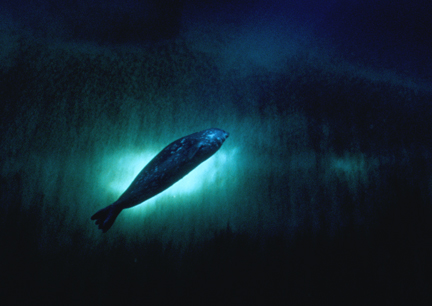
Weddell seal ascending from the depths
Malcolm approached one territorial male and triggered his camera. The seal stared in curiosity, then glanced around, as if asking for help from his fellows in making sense of the bubbling monstrosity before him.
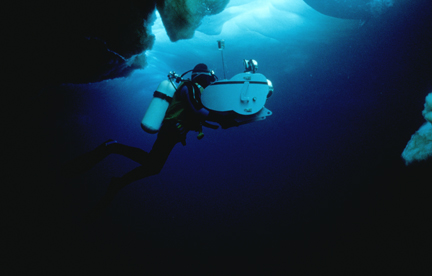
Malcolm and his massive IMAX camera
Without warning, a heart-stopping, high-pitched moan pierced the water. I had heard this sound before, but only from the surface where its force was muted by the intervening ice. Here beneath the ice the sound was overwhelming in its intensity, filling the sea and reverberating through my flesh. It seemed to come from everywhere at once.
I knew this haunting cry was the call of a Weddell seal, but that did not diminish its chilling effect. I looked around. It was probably a male, and the volume of the cry indicated that he was close by.
I found him hovering at the entrance to an ice cave to my left, directing his call to another seal inside. His throat pulsated with the effort. The moan dropped quickly in pitch, then tapered slowly off to a cicada-like buzz before finally dissipating. Malcolm and I looked at each other, each of us probably thinking the same thing. It was easy to believe we were no longer on planet Earth.
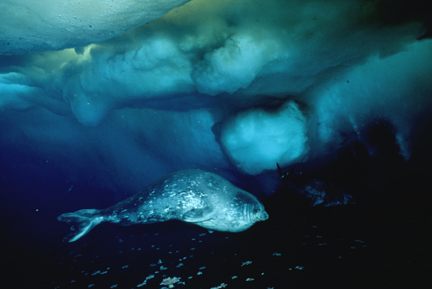
Weddell seal vocalizing
The spectacular visibility, well over 500 feet, amplified the sense of mystery and discovery. I could see as far as the broken ice would let me. The feeling of floating, weightless, in a blue, alien universe was overwhelming. The sound of my breathing and exhausted bubbles seemed to shatter the silence, a silence punctuated only by the baleful calls of far off Weddells.
I readjusted my buoyancy and dropped down a few feet to peer under an ice ledge. On the other side I could see another crack system, populated by other seals, and rimmed by vast canyon walls as spectacular as the ones on either side of me. At that moment the world we were in seemed endless, a vast citadel in which Malcolm and I were but gnats, hovering and bubbling and all but ignored by the graceful, aloof inhabitants.
Malcolm continued to film, getting as close as the seals would allow. I hovered out of the way, ready to lend assistance to him if necessary, and continued to stare in awe at my surroundings. Out of habit, I turned to look back the way we had come, checking for the down line. We had traveled several hundred feet, yet the down line, partially hidden behind a cluster of ice sheets, was still clear to see, its strobe lights flashing comfortingly.
I looked down. How far below me the bottom was I had no idea. I watched a seal coast downward, growing smaller and fainter and finally fading into the blue darkness. I wondered what mysteries hid in those depths, forever out of my reach. Above me and to the left, the thick, battered ice showed a character not seen from the surface. The telltale lines of old cracks spider-webbed across the underside like the pattern of breaks in a piece of shattering glass. In every direction I could see the bright spots of present and former seal breathing holes.
Finally, Malcolm signaled to me that he was out of film. Reluctantly, we turned and headed back the way we had come. Once again we passed through the tunnel of ice that had served as our doorway to this universe. At the same time, a large seal entered from the other side, swimming toward us. We passed within inches of each other, the seal hardly disturbed, Malcolm fuming that he was out of film.
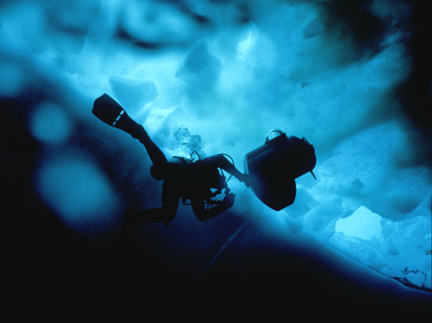
Heading back to the surface
On the other side of the tunnel the bottom once more appeared below us. Back at the entry point, Malcolm and I pushed the camera from below as his assistants muscled it out of the water. Malcolm immediately followed it.
It was a sad moment for me, for I did not want to leave the water. I floated just below the surface, looking around at the wondrous universe I had discovered. Finally, I sighed into my regulator and headed up. Alison helped pull me from the water.
The surface world was as I had left it. Bright, blinding sun beat down from a cloudless sky, glaring and reflecting from every multi-faceted ice crystal. The black wall of Hutton Cliffs towered over us. This was the Antarctica I was accustomed to–a world of stark, contrasting blacks and whites. But as spectacular as it was, and is, it seemed at that moment a poor substitute for the blue world beneath the ice. I envied the seals their comfort and grace in that world, a world that I could only enter with elaborate technology.
As we began removing our gear and packing it into the Spryte for the ride home, I was suddenly struck by the realization that the same advanced technology which gave me access to the seals’ world also threatens it. Human presence in the Antarctic grows each year, and more and more eyes are seeing not the beauty of the land but the wealth which may lie beneath it.
I thought about McMurdo Station–with its fuel drums, raw sewage, and smoke-belching diesel engines–and saw it as a clear harbinger of what could come. I envisioned the seals’ undersea realm swirling with greasy streaks of crude oil, the seals themselves coated with the thick, black stuff. The image made me shudder.
If Antarctica is indeed like another planet (and I’m certainly not the first to describe it in those terms) then it takes on an importance far beyond its earthly value. In a future full of promise for humanity’s exodus into space, this Land of Ice becomes the proving ground for our behavior on other worlds. Will we treat them with the same abandon we have shown the Earth? Will we blithely pollute every place we set our feet? Or will we channel our efforts and resources into finding a better way?
Antarctica, I realized that day at Hutton Cliffs, is truly our last chance on Earth to change our ways.
